Innovative Stress Release Stimulation Through Sequential Cavity Completion for CBM Reservoir Enhancement
Abstract
1. Introduction
2. Methods
2.1. Caving Disturbance–Stress Distribution Model
2.2. Response Model of Pore Permeability Under Stress Release Effect
2.2.1. Model of Pore Permeability Under Stress Release
2.2.2. Boundary Conditions of the Model
2.3. Construction of Numerical Models
2.3.1. Modeling Geometric of Numerical Model
2.3.2. Boundary Conditions and Assignment Loading
3. Results and Analysis
3.1. The Distribution of Reservoir Stress Under Cave Disturbance
3.2. Reservoir Stress Release Under Different Fluid Pressures
3.3. Permeability Evolution Under Stress Release Effect
4. Sequential-Cavity-Induced Stress Release for Horizontal Wells
4.1. Stress Distribution of Sequential Cavity Completion for Horizontal Wells
4.2. Sequential Cavity Completion for Stress Release in Horizontal Wells
5. Conclusions
- (1)
- Conventional discrete models for coalbed stress release are limited to shallow protective layer mining scenarios and neglect critical mechanisms governing deep coalbed methane (CBM) systems, including high in situ stresses, non-linear elastoplastic deformation, and cavitation-induced stress perturbations. To address this gap, a novel stress–seepage coupling framework is proposed by considering the elastoplastic transition mechanisms during stress release, fluid pressure dynamics, and rock–fluid interactions involving diffusion/adsorption-induced deformation. The model uniquely resolves permeability evolution during deep stress redistribution triggered by cavity formation, advancing fundamental insights into stress–seepage interdependencies.
- (2)
- Aiming at the complex conditions of high stress and non-linear deformation in deep coalbed methane reservoirs, the fully coupled fluid–solid mechanics 3D discrete element model (FLC3D) was established, quantitatively revealing the asymmetric impact of dynamic fluid pressure changes on permeability. This study found that, when fluid pressure decreases from 12 MPa to 1 MPa, the stress release zone volume shrinks by 17%, while the stress concentration zone expands by 31%. Permeability in the release zone can increase to 5.8 mD (a 483% enhancement), whereas it declines by 50–70% in the concentration zone. This dynamic evolution pattern provides critical theoretical guidance for optimizing drainage parameters in deep reservoirs.
- (3)
- This work proposes an innovative sequential cavity completion–hydraulic fracturing synergistic technology, overcoming the limitations of traditional single-method approaches. By actively injecting high-pressure fluid into stress concentration zones at the cavity ends through hydraulic fracturing, the compressive stress effect is directly counteracted (peak stress reaches 2.54 times the initial value), achieving the dynamic neutralization of stress concentration zones and permeability restoration. This combined technology not only expands the stress release range, but also addresses the energy transfer constraints caused by high stress in deep reservoirs, providing a new engineering paradigm for deep coalbed methane development.
Author Contributions
Funding
Data Availability Statement
Conflicts of Interest
References
- Xu, H.; Tang, D.; Mathews, J.P.; Zhao, J.; Li, B.; Tao, S. Evaluation of coal macrolithotypes distribution by geophysical logging data in the Hancheng Block, Eastern Margin, Ordos Basin, China. Int. J. Coal Geol. 2016, 165, 265–277. [Google Scholar] [CrossRef]
- Li, S.; Qin, Y.; Tang, D.; Shen, J.; Wang, J.; Chen, S. A comprehensive review of deep coalbed methane and recent developments in China. Int. J. Coal Geol. 2023, 279, 104369. [Google Scholar] [CrossRef]
- Liu, Y.; Xu, H.; Tang, D.; Mathews, J.P.; Zhai, Y.; Hou, W. The impact of the coal macrolithotype on reservoir productivity, hydraulic fracture initiation and propagation. Fuel 2019, 239, 471–483. [Google Scholar] [CrossRef]
- Fan, T.; Zhang, G. Laboratory investigation of hydraulic fracture networks in formations with continuous orthogonal fractures. Energy 2014, 74, 164–173. [Google Scholar] [CrossRef]
- Meng, S.; Hou, B.; Zhang, J. Experimental research on hydraulic fracture propagation through mixed layers of shale, tight sand and coal seam. J. China Coal Soc. 2016, 41, 221–227. [Google Scholar]
- Li, Q.; Li, Q.C.; Wu, J.; Li, X.; Li, H.; Cheng, Y. Wellhead Stability During Development Process of Hydrate Reservoir in the Northern South China Sea: Evolution and Mechanism. Processes 2025, 13, 40. [Google Scholar] [CrossRef]
- Li, Q.; Li, Q.C.; Cao, H.; Wu, J.; Wang, F.; Wang, Y. Analysis of casing deformation failure mechanism based on fault slip. Processes 2025, 13, 159. [Google Scholar] [CrossRef]
- Shi, R.; Liu, J.; Wei, M.; Derek, E.; Wang, X. Mechanistic analysis of coal permeability evolution data under stress-controslled conditions. Int. J. Coal Geol. 2018, 110, 36–47. [Google Scholar]
- Souley, M.; Renaud, V.; AlHeib, M.; Bouffier, C.; Lahaie, F.; Nyström, A. Numerical investigation of the development of the excavation damaged zone around a deep polymetallic ore mine. Int. J. Rock Mech. Min. Sci. 2018, 106, 165–175. [Google Scholar] [CrossRef]
- Xie, H.; Zhao, X.; Liu, J.; Zhang, R. Influence of different mining layouts on the mechanical properties of coal. Int. J. Min. Sci. Technol. 2012, 22, 749–755. [Google Scholar] [CrossRef]
- Vazaios, I.; Vlachopoulos, N.; Diederichs, M. Assessing fracturing mechanisms and evolution of excavation damaged zone of tunnels in interlocked rock masses at high stresses using a finite-discrete element approach. J. Rock Mech. Geotech. Eng. 2019, 11, 701–722. [Google Scholar] [CrossRef]
- Sang, S.; Xu, H.; Fang, L.; Li, G.; Huang, H. Stress relief coalbed methane drainage by surface vertical wells in China. Int. J. Coal Geol. 2010, 82, 196–203. [Google Scholar] [CrossRef]
- Shi, J.; Durucan, S. Drawdown induced changes in permeability of coalbeds: A new interpretation of the reservoir response to primary recovery. Transp. Porous Media 2004, 56, 1–16. [Google Scholar] [CrossRef]
- Kong, X.; Wang, E.; Liu, Q.; Li, Z.; Li, D.; Cao, Z.; Niu, Y. Dynamic permeability and porosity evolution of coal seam rich in CBM based on the flow-solid coupling theory. J. Nat. Gas Sci. Eng. 2017, 40, 6–25. [Google Scholar] [CrossRef]
- Duan, M.; Jiang, C.; Xing, H.; Zhang, D.; Peng, K.; Zhang, W. Study on damage of coal based on permeability and load-unload response ratio under tiered cyclic loading. Arab. J. Geosci. 2020, 13, 250. [Google Scholar] [CrossRef]
- Zeng, K.; Xu, J.; He, P.; Wang, C. Experimental Study on Permeability of Coal Sample Subjected to Triaxial Stresses. Procedia Eng. 2011, 26, 1051–1057. [Google Scholar] [CrossRef]
- Ben, A.; Aubertin, M.; Simon, R. Numerical simulations of water flow and contaminants transport near mining wastes disposed in a fractured rock mass. Int. J. Min. Sci. Technol. 2015, 25, 37–45. [Google Scholar]
- Lisjak, A.; Figi, D.; Grasselli, G. Fracture development around deep underground excavations: Insights from FDEM modelling. J. Rock Mech. Geotech. Eng. 2014, 6, 493–505. [Google Scholar] [CrossRef]
- Vaziri, H.H.; Palmer, I.D. Evaluation of openhole cavity completion technique in coalbed methane reservoirs. Int. J. Rock Mech. Min. Sci. 1998, 35, 523–524. [Google Scholar] [CrossRef]
- Sang, S.; Zhou, X.; Liu, S. Research advances in theory and technology of the stress release applied extraction of coalbed methane from tectonically deformed coals. J. China Coal Soc. 2020, 45, 13–28. [Google Scholar]
- Yang, R.; Huang, Z.; Li, G.; Chen, J.; Wen, H.; Qin, X. Feasibility Investigation of Hydraulic jet multistage cavity completion in coalbed methane horizontal wells. J. China Coal Soc. 2022, 47, 3284–3298. [Google Scholar]
- Xie, H.; Xie, J.; Gao, M.; Zhang, R.; Zhou, H.; Gao, F. Theoretical and experimental validation of mining-enhanced permeability for simultaneous exploitation of coal and gas. Environ. Earth Sci. 2015, 73, 5951–5962. [Google Scholar] [CrossRef]
- Taheri, A.; Sereshki, F.; Doulati, A.; Mirzaghorbanali, A. Numerical modeling of gas flow in coal pores for methane drainage. J. Sustain. Min. 2016, 15, 95–99. [Google Scholar] [CrossRef]
- Xue, Y.; Ranjith, P.; Gao, F.; Zhang, D.; Cheng, H.; Chong, Z.; Hou, P. Mechanical behaviour and permeability evolution of gas-containing coal from unloading confining pressure tests. J. Nat. Gas Sci. Eng. 2017, 40, 336–346. [Google Scholar] [CrossRef]
- Wang, Z.; Sang, S.; Zhou, X.; Liu, S.; Wang, H.; Shu, Y. Response in coal reservoirs and in-situ stress control during horizontal well coal cavern completion and stress release. Gas Sci. Eng. 2023, 113, 204950. [Google Scholar] [CrossRef]
- Qian, M.; Xu, J. Study on the “O-shape” circle distribution characteristics of mining-induced fractures in the overlying strata. J. China Coal Soc. 1998, 23, 466–469. [Google Scholar]
- Qian, M. A Study of the Behaviour of Overlying Strata in Longwall Mining and its Application to Strata Control. Strat. Mech. 1982, 1, 13–17. [Google Scholar]
- Qian, M. Theory and Practice of Surrounding Rock Control in Stopes. J. Min. Saf. Eng. 1999, 29, 12–15. [Google Scholar]
- Du, X. Research on the Evolution and Its Application of Rock Pressure Arch in Coal Mining; China University of Mining and Technology: Xuzhou, China, 2011. [Google Scholar]
- Pan, Z.; Connell, L. Modelling of anisotropic coal swelling and its impact on permeability behaviour for primary and enhanced coalbed methane recovery. Int. J. Coal Geol. 2011, 85, 257–267. [Google Scholar] [CrossRef]
- Li, Q.; Deng, Y.; Li, J.; Shi, W. Roughness characterization and formation mechanism of abrasive air jet micromachining surface studied by power spectral density. J. Manuf. Process. 2020, 57, 737–747. [Google Scholar] [CrossRef]
- Yin, G.; Jiang, C.; Wang, J.; Jiang, X. Geomechanical and flow properties of coal from loading axial stress and unloading confining pressure tests. Int. J. Rock Mech. Min. Sci. 2015, 76, 155–161. [Google Scholar] [CrossRef]
- Cui, W.; Liu, Q.; Wu, Z.; Xu, X. Fracture development around wellbore excavation: Insights from a 2D thermo-mechanical FDEM analysis. Eng. Fract. Mech. 2024, 295, 109774. [Google Scholar] [CrossRef]
- Zhang, Z.; Zhang, R.; Xie, H.; Gao, M.; Zha, E.; Jia, Z. An anisotropic coal permeability model that considers mining-induced stress evolution, microfracture propagation and gas sorption-desorption effects. J. Nat. Gas Sci. Eng. 2017, 46, 664–679. [Google Scholar] [CrossRef]
- Liu, Y.; Wei, K.; Wang, A.; Fang, Q.; Wang, C. Dynamic Permeability Response and Pore-Fracture Structure Evolution of Deep Coal Reservoirs Under Stress Release. Nat. Resour. Res. 2025, 34, 953–982. [Google Scholar] [CrossRef]
- Lisjak, A.; Grasselli, G.; Vietor, T. Continuum-discontinuum analysis of failure mechanisms around unsupported circular excavations in anisotropic clay shales. Int. J. Rock Mech. Min. Sci. 2014, 65, 96–115. [Google Scholar] [CrossRef]
- Xue, Y.; Gao, F.; Gao, Y.; Cheng, H.; Liu, Y.; Hou, P. Quantitative evaluation of stress relief and permeability-increasing effects of overlying coal seams for coal mine methane drainage in Wulan coal mine. J. Nat. Gas Sci. Eng. 2016, 32, 122–137. [Google Scholar] [CrossRef]
- Robertson, E.; Christiansen, R. A Permeability model for coal and other fractured, sorptive-elastic media. SPE J. 2006, 13, 314–324. [Google Scholar] [CrossRef]
- Hong, C.; Yang, R.; Huang, Z.; Liu, W.; Cong, R. Experimental investigation on coal-breakage performances by abrasive nitrogen-gas jet with a conical nozzle. Int. J. Rock Mech. Min. Sci. 2021, 142, 104781. [Google Scholar] [CrossRef]
- Wang, C.; Yang, S.; Li, X. Comparison of the initial gas desorption and gas-release energy characteristics from tectonically-deformed and primary-undeformed coal. Fuel 2019, 238, 66–74. [Google Scholar] [CrossRef]
- Liu, Z.; Cheng, Y.; Liu, Q.; Jiang, J.; Li, W.; Zhang, K. Numerical assessment of CMM drainage in the remote unloaded coal body: Insights of geostress-relief gas migration and coal permeability. J. Nat. Gas Sci. Eng. 2017, 45, 487–501. [Google Scholar] [CrossRef]
- Liu, Q.; Cheng, Y.; Zhou, H.; Guo, P.; An, F.; Chen, H. A mathematical model of coupled gas flow and coal deformation with gas diffusion and klinkenberg effects. Rock Mech. Rock Eng. 2015, 48, 1163–1180. [Google Scholar] [CrossRef]
- Xu, F.; Nie, Z.; Sun, W. Theoretical and technological system for highly efficient development of deep coalbed methane in Daning-Jixian Block. J. Chin. Coal Soc. 2023, 1, 1–18. [Google Scholar]
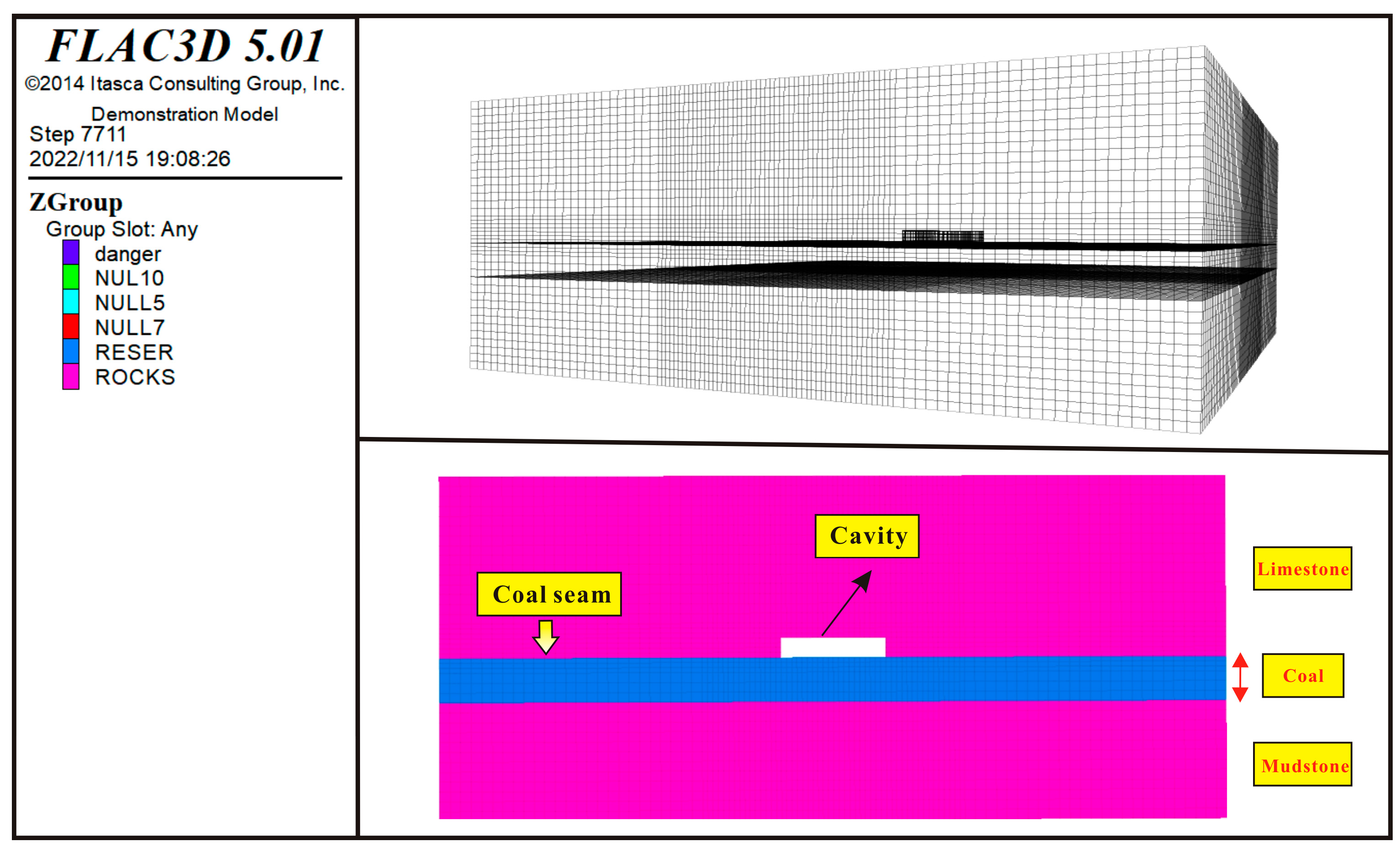


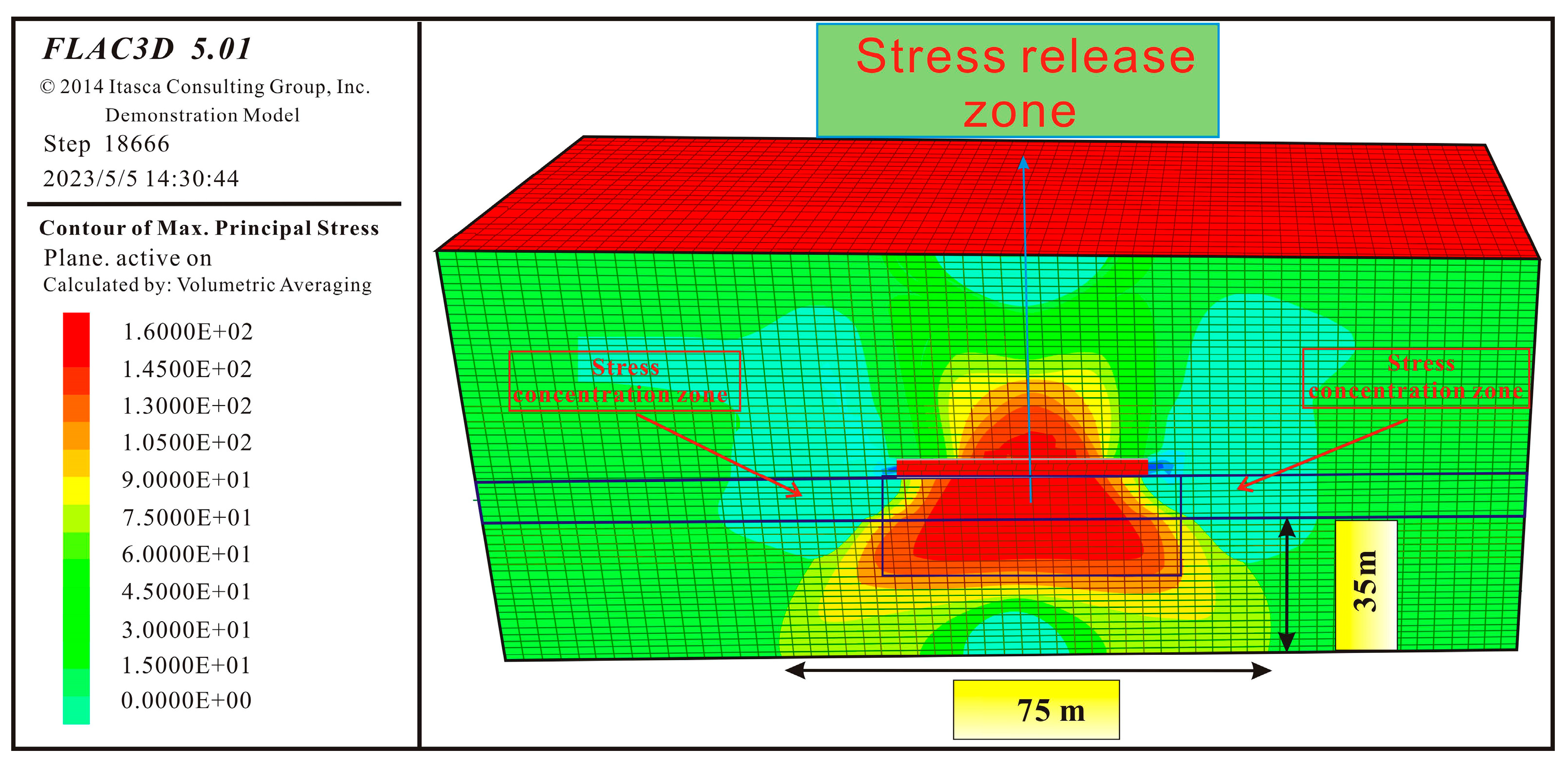


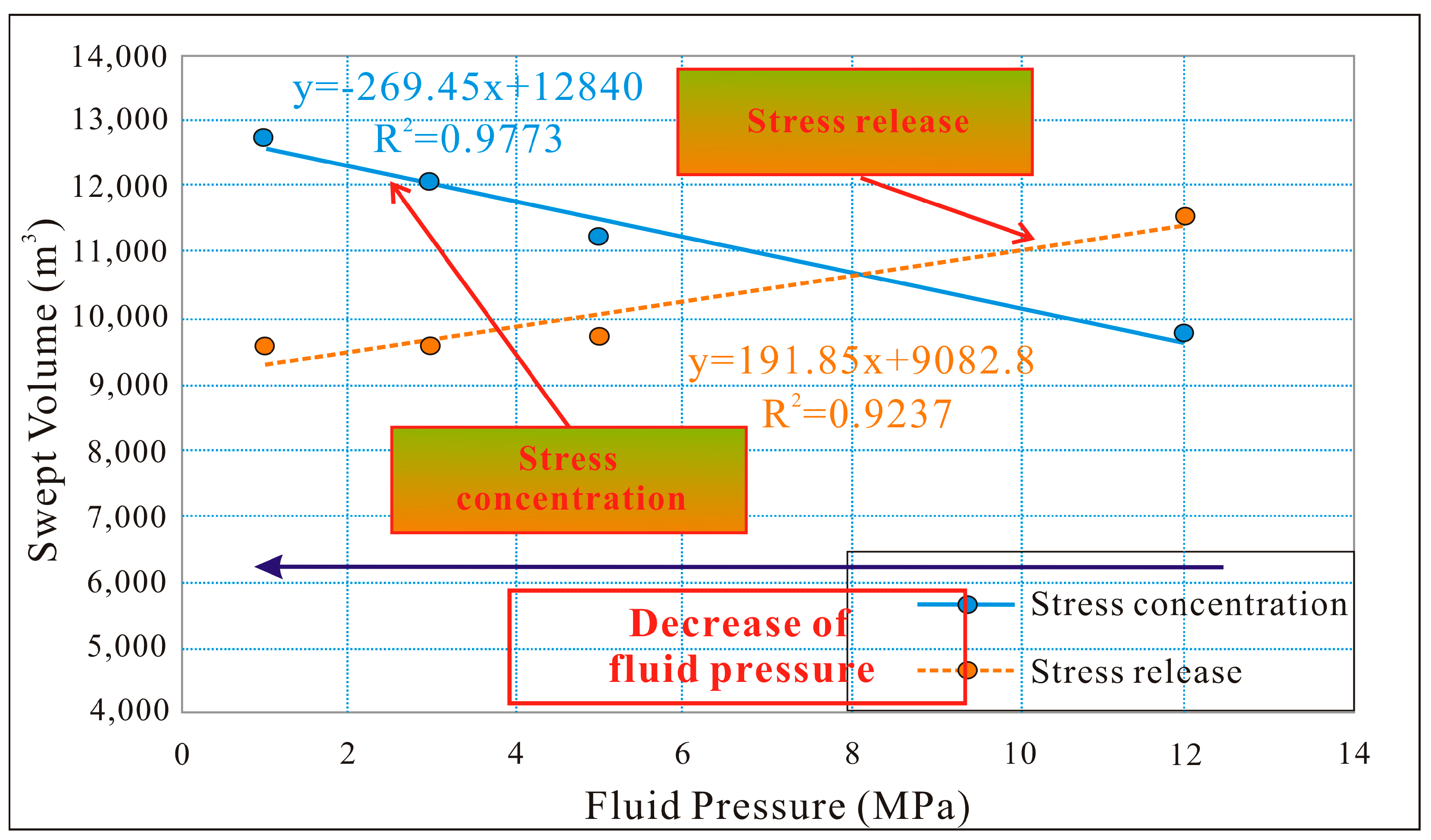
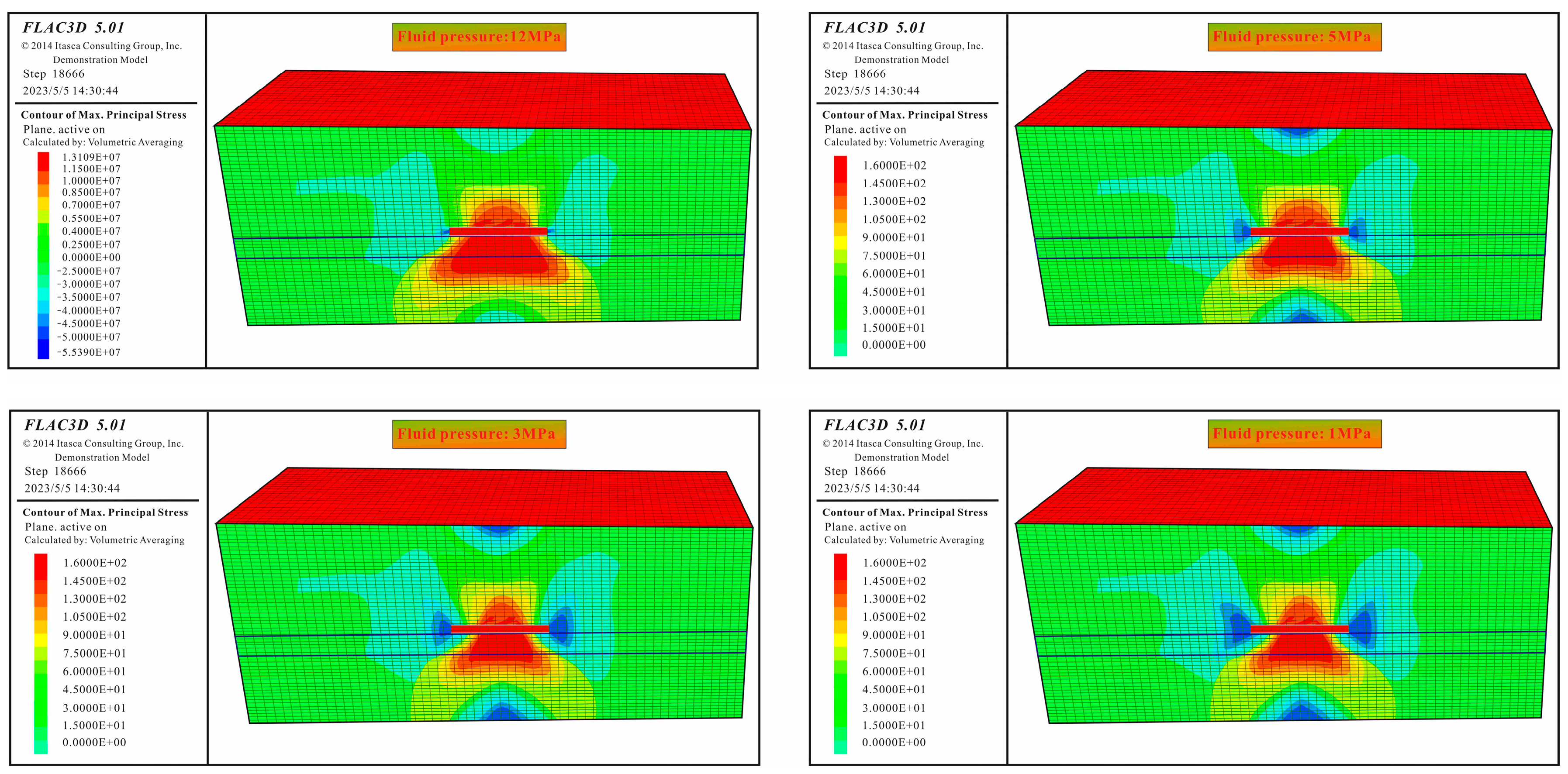
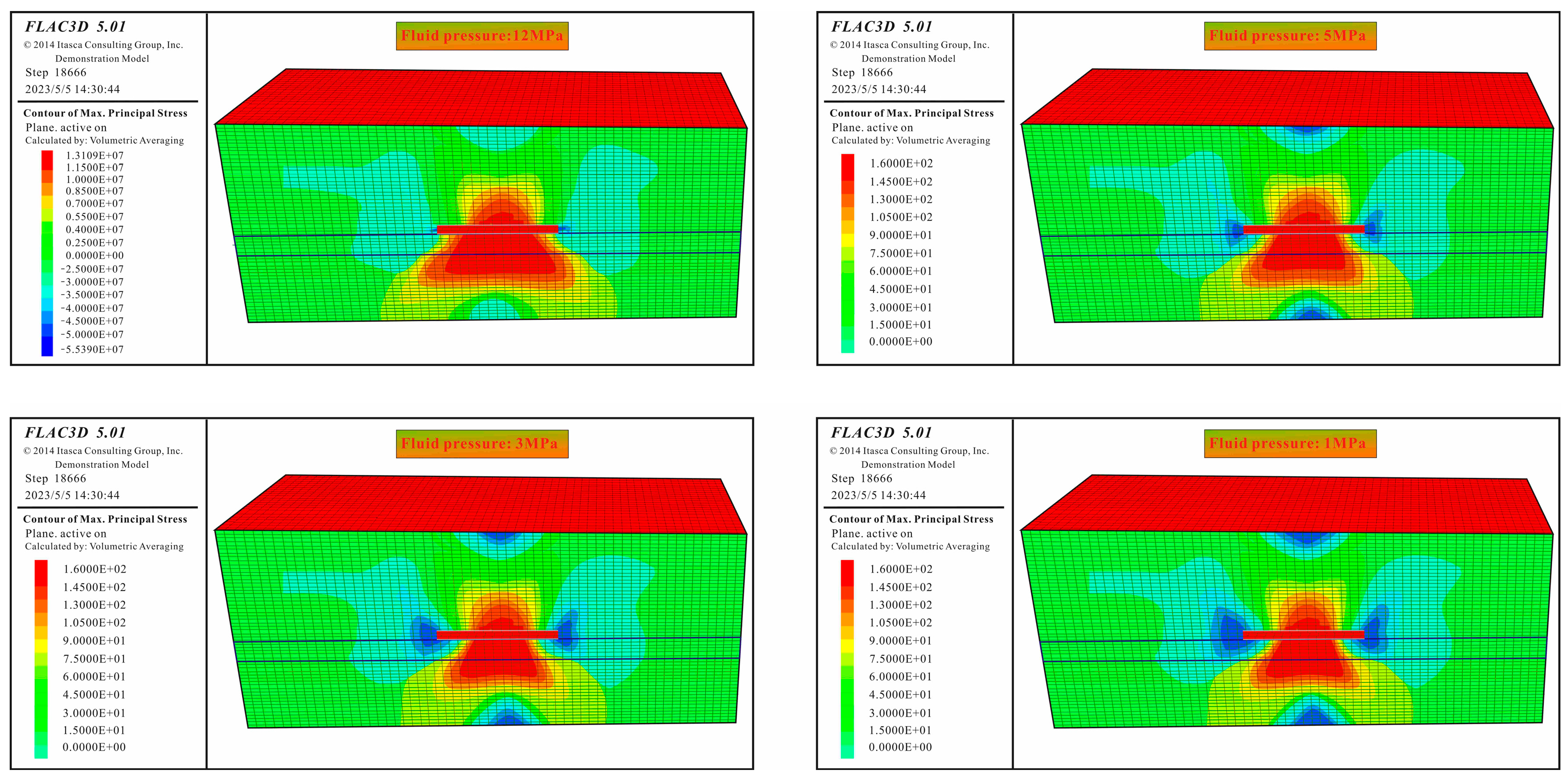

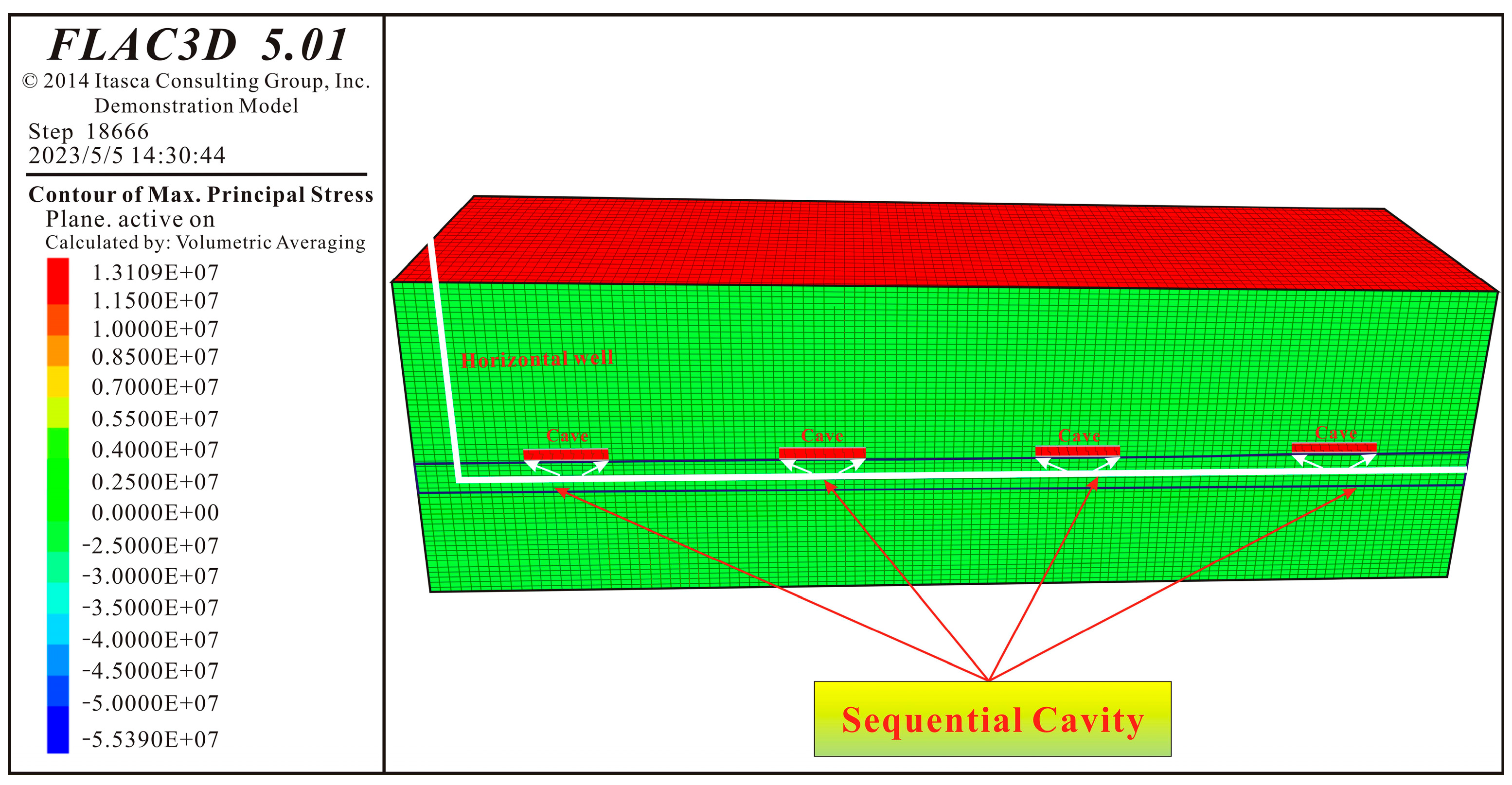


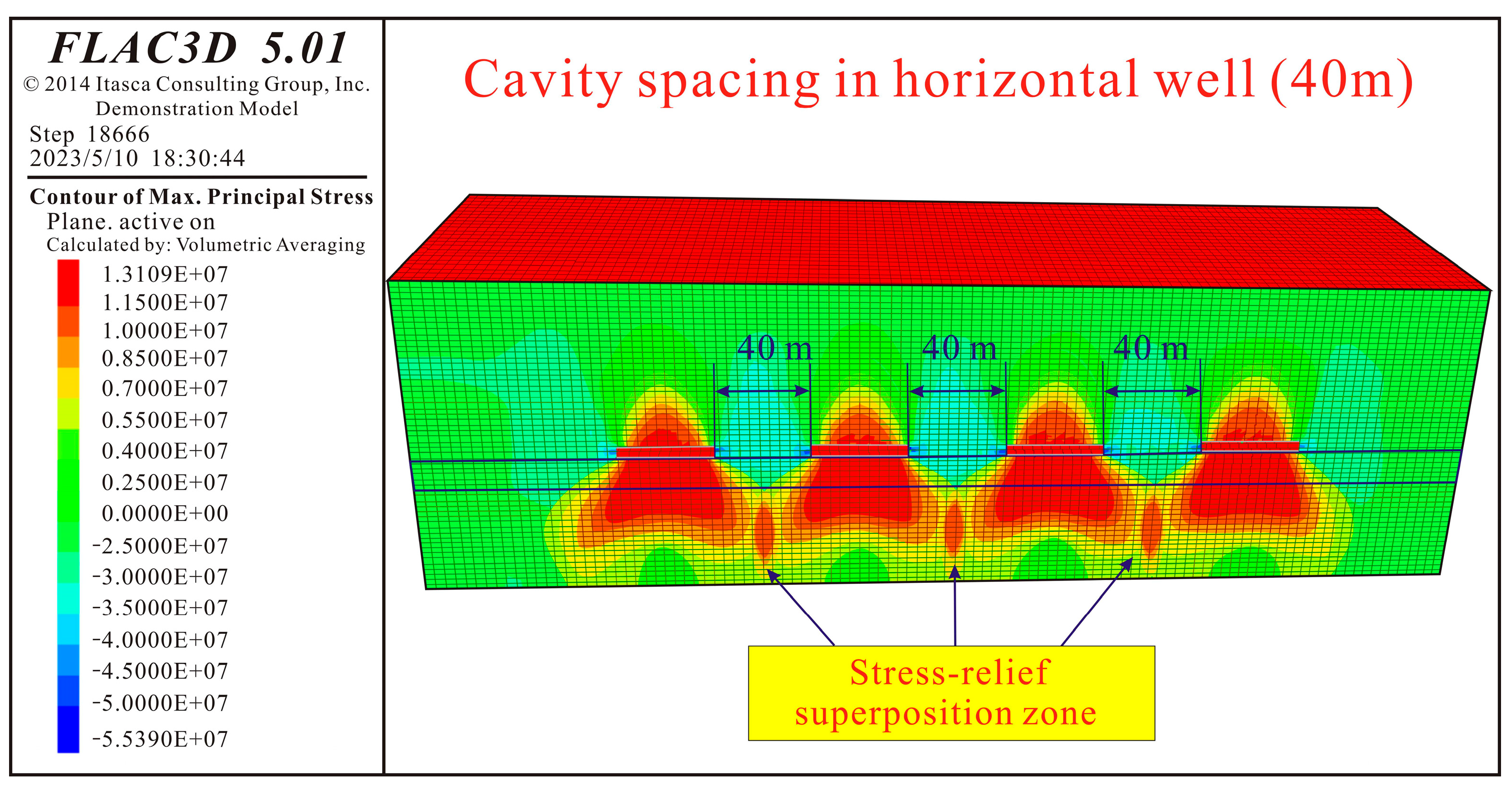
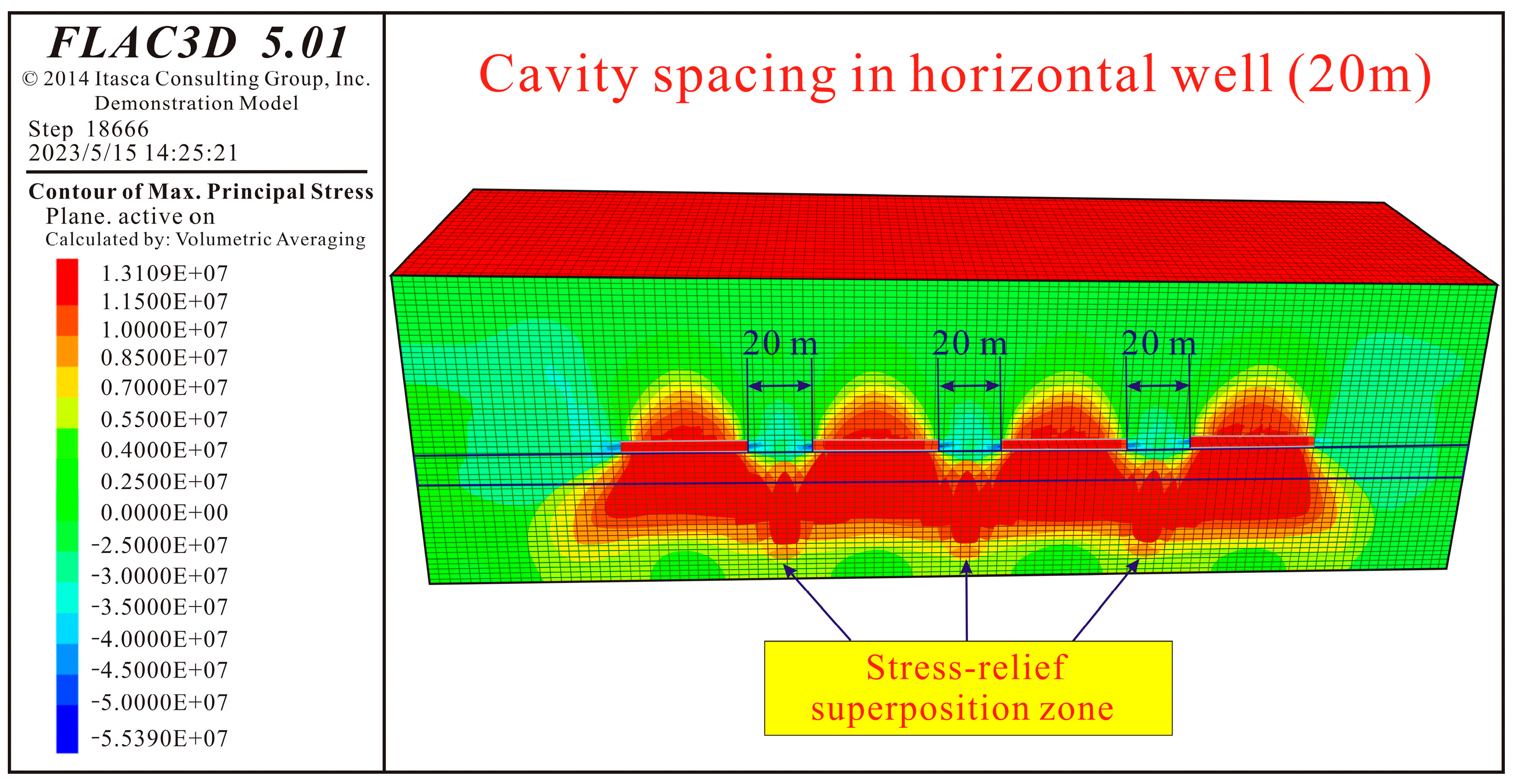
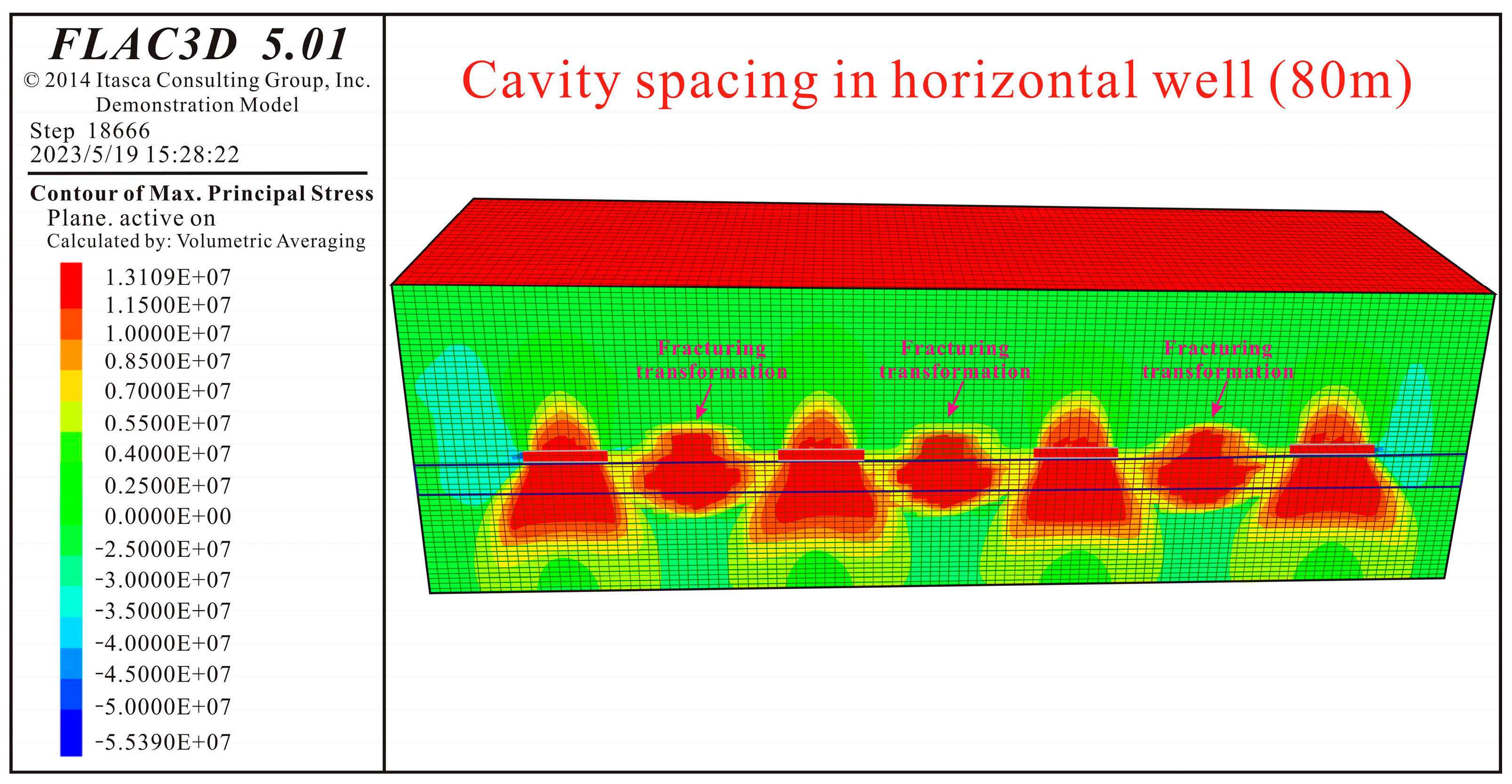
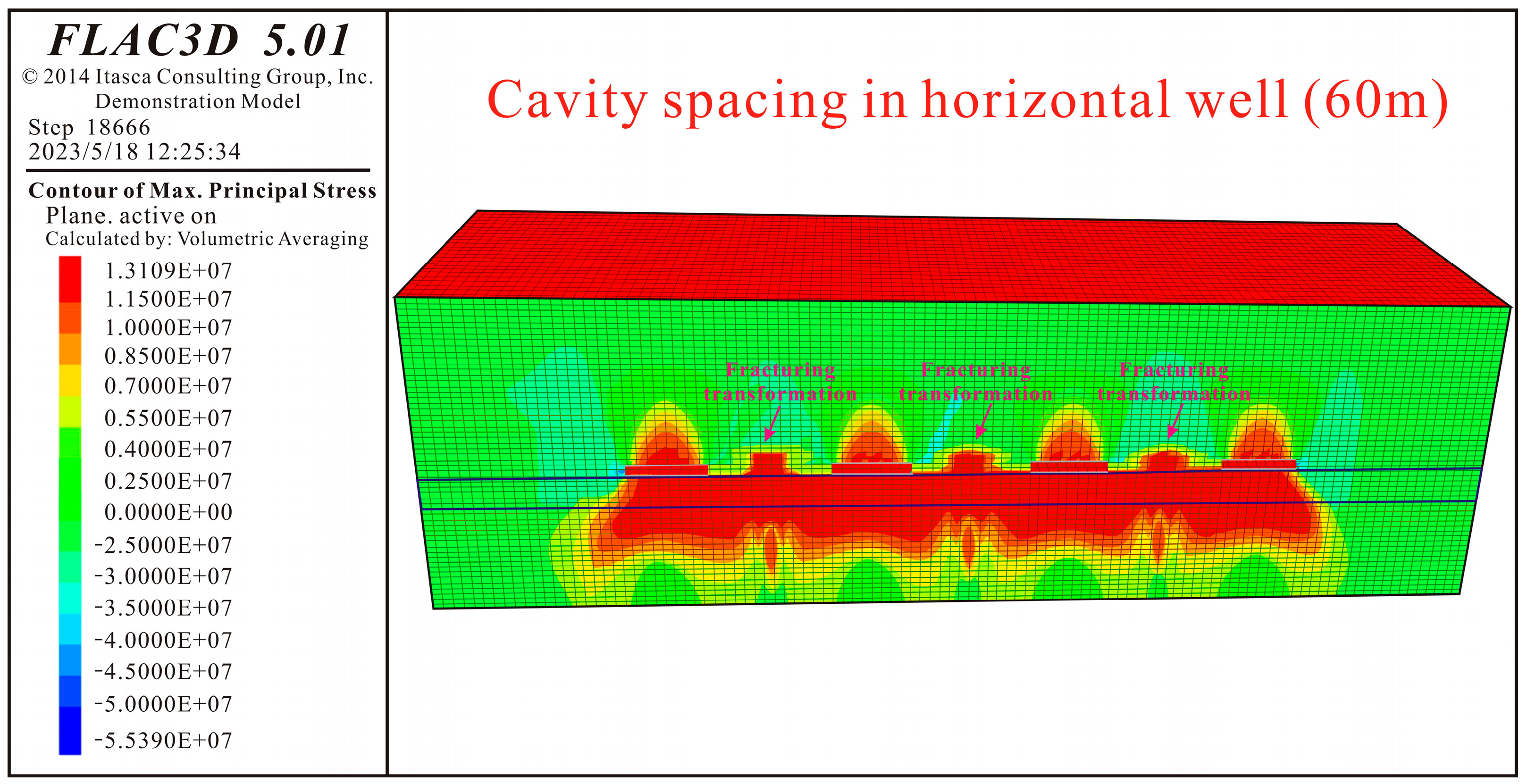
| Rockiness | Weight Capacity (kg/m3) | Bulk Modulus (GPa) | Tensile Strength (MPa) | Compressive Strength (MPa) | Cohesive Force (MPa) | Angle of Internal Friction (°) |
|---|---|---|---|---|---|---|
| Limestone | 2.601 | 36.23 | 1.94 | 27.52 | 28.7 | 34°55′ |
| Coal seam | 1.41 | 3.12 | 1.34 | 18.32 | 1.65 | 25°51′ |
| Mudstone | 2.538 | 2.31 | 1.59 | 21.32 | 19.7 | 31°39′ |
Disclaimer/Publisher’s Note: The statements, opinions and data contained in all publications are solely those of the individual author(s) and contributor(s) and not of MDPI and/or the editor(s). MDPI and/or the editor(s) disclaim responsibility for any injury to people or property resulting from any ideas, methods, instructions or products referred to in the content. |
© 2025 by the authors. Licensee MDPI, Basel, Switzerland. This article is an open access article distributed under the terms and conditions of the Creative Commons Attribution (CC BY) license (https://creativecommons.org/licenses/by/4.0/).
Share and Cite
Zhen, H.; Zhao, H.; Wei, K.; Liu, Y.; Li, S.; Wei, Z.; Wang, C.; Chen, G. Innovative Stress Release Stimulation Through Sequential Cavity Completion for CBM Reservoir Enhancement. Processes 2025, 13, 1567. https://doi.org/10.3390/pr13051567
Zhen H, Zhao H, Wei K, Liu Y, Li S, Wei Z, Wang C, Chen G. Innovative Stress Release Stimulation Through Sequential Cavity Completion for CBM Reservoir Enhancement. Processes. 2025; 13(5):1567. https://doi.org/10.3390/pr13051567
Chicago/Turabian StyleZhen, Huaibin, Haifeng Zhao, Kai Wei, Yulong Liu, Shuguang Li, Zhenji Wei, Chengwang Wang, and Gaojie Chen. 2025. "Innovative Stress Release Stimulation Through Sequential Cavity Completion for CBM Reservoir Enhancement" Processes 13, no. 5: 1567. https://doi.org/10.3390/pr13051567
APA StyleZhen, H., Zhao, H., Wei, K., Liu, Y., Li, S., Wei, Z., Wang, C., & Chen, G. (2025). Innovative Stress Release Stimulation Through Sequential Cavity Completion for CBM Reservoir Enhancement. Processes, 13(5), 1567. https://doi.org/10.3390/pr13051567






